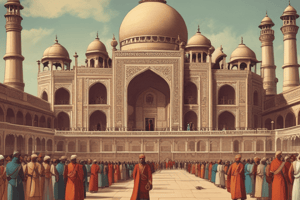Podcast
Questions and Answers
Which Mughal ruler's excessive taxation and religious policies led to widespread rebellions within the empire?
Which Mughal ruler's excessive taxation and religious policies led to widespread rebellions within the empire?
- Jahangir
- Babur
- Shah Jahan
- Aurangzeb (correct)
What significant event marked the reduced state of the Mughal Empire by 1857?
What significant event marked the reduced state of the Mughal Empire by 1857?
- Trade expansion between East and West Indies
- Construction of Agra Fort
- British East India Company gaining power (correct)
- Building of Taj Mahal
During the reign of which Mughal emperor did magnificent architectural structures like the Red Fort get constructed?
During the reign of which Mughal emperor did magnificent architectural structures like the Red Fort get constructed?
- Shah Jahan (correct)
- Aurangzeb
- Babur
- Jahangir
What was a significant factor that contributed to the prosperity of the Mughal Empire under Jahangir and Shah Jahan?
What was a significant factor that contributed to the prosperity of the Mughal Empire under Jahangir and Shah Jahan?
What was one of the enduring legacies left by the Mughal Empire, as mentioned in the text?
What was one of the enduring legacies left by the Mughal Empire, as mentioned in the text?
Which event signified the beginning of conflicts between the British East India Company and Mughal rulers?
Which event signified the beginning of conflicts between the British East India Company and Mughal rulers?
Who founded the Mughal Empire?
Who founded the Mughal Empire?
Who declared himself king of northern India after defeating Ibrahim Lodi?
Who declared himself king of northern India after defeating Ibrahim Lodi?
During which period was the Mughal Empire considered to be in its 'Golden Age'?
During which period was the Mughal Empire considered to be in its 'Golden Age'?
Who transformed the Mughal Empire into its Golden Age, known for consolidating authority and instituting Din-i-Ilāhī?
Who transformed the Mughal Empire into its Golden Age, known for consolidating authority and instituting Din-i-Ilāhī?
Which religion was a blend of Hinduism, Islam, Buddhism, and Zoroastrianism and was instituted by Akbar?
Which religion was a blend of Hinduism, Islam, Buddhism, and Zoroastrianism and was instituted by Akbar?
Which grandson of Babur launched massive campaigns against Rajputs and Marathas to integrate diverse regions under Mughal rule?
Which grandson of Babur launched massive campaigns against Rajputs and Marathas to integrate diverse regions under Mughal rule?
Flashcards
Mughal Empire
Mughal Empire
A powerful dynasty that ruled over parts of India from the late 16th to early 19th centuries.
Babur
Babur
Founder of the Mughal Empire, who invaded northern India in 1526.
Humayun
Humayun
Babur's son who briefly ruled part of the empire, but lost it due to strife.
Akbar
Akbar
Signup and view all the flashcards
Golden Age (Mughal)
Golden Age (Mughal)
Signup and view all the flashcards
Aurangzeb
Aurangzeb
Signup and view all the flashcards
Din-i-Ilahi
Din-i-Ilahi
Signup and view all the flashcards
Mughal architecture
Mughal architecture
Signup and view all the flashcards
Sepoy Mutiny
Sepoy Mutiny
Signup and view all the flashcards
British East India Company
British East India Company
Signup and view all the flashcards
Delhi Sultanate
Delhi Sultanate
Signup and view all the flashcards
Rajputs and Marathas
Rajputs and Marathas
Signup and view all the flashcards
Political ascension
Political ascension
Signup and view all the flashcards
Study Notes
A Glance at the Mughal Empire's History
Stretching across India from the late 16th century until the early 19th century, the Mughal Empire was one of history's most powerful dynasties. This vast realm was founded by Babur – a descendant of both Genghis Khan and Timur the Lame – who initially aimed to expand his territorial control within Central Asia before moving into India. Along with political ascension came cultural flourishing; the Mughals left indelible marks on Indian society, economy, architecture, and art during their reign.
Origins and Early Expansion (1526–1580)
Babur's successful invasion of northern India in 1526 marked the first step towards establishing the formidable Mughal rule. After defeating Ibrahim Lodi, Sultan of the Delhi Sultanate, he declared himself king. His son Humayun inherited this kingdom after Babur's death but lost it shortly thereafter due to internal strife and military uprisings. In 1556 Akbar, another grandson of Babur, seized power and launched massive campaigns against Rajputs and Marathas, integrating diverse regions under his banner.
Golden Age (1580–1658)
Akbar reigned over nearly three decades, transforming the fledgling enterprise into what would become known as the Mughal Empire's golden age. He consolidated his authority through treaties, marriages, and diplomatic ties while also instituting the Din-i-Ilāhī – a syncretic religion blending elements of Hinduism, Islam, Buddhism, and Zoroastrianism. Under his successors Jahangir and Shah Jahan, this era became even more prosperous due largely to trade expansion between East and West Indies and provincial autonomy improvement. During these years, some examples of magnificent Mughal architecture were built, including Agra Fort, Taj Mahal, and Red Fort.
Decline (1658–1857)
The gradual collapse of the once-mighty Mughal rule began around 1658 when Aurangzeb took reign following his brothers' deaths. His excessive taxation and religious policies alienated various factions within his own empire, leading to widespread rebellions. Moreover, Britain's rise as a global superpower fueled conflicts with Mughal rulers, resulting in the British East India Company gradually gaining ground. By the time the Sepoy Mutiny broke out in 1857, the Mughal Empire had already been reduced to a mere shadow of its former self.
In summary, the Mughal Empire transformed the landscape of South Asian politics and culture throughout four centuries. Despite its eventual decline and disintegration, this historical entity imparted lasting legacies, particularly in terms of art, architecture, administration, and statecraft, leaving an enduring impression on modern-day societies and cultures within the region.
Studying That Suits You
Use AI to generate personalized quizzes and flashcards to suit your learning preferences.




